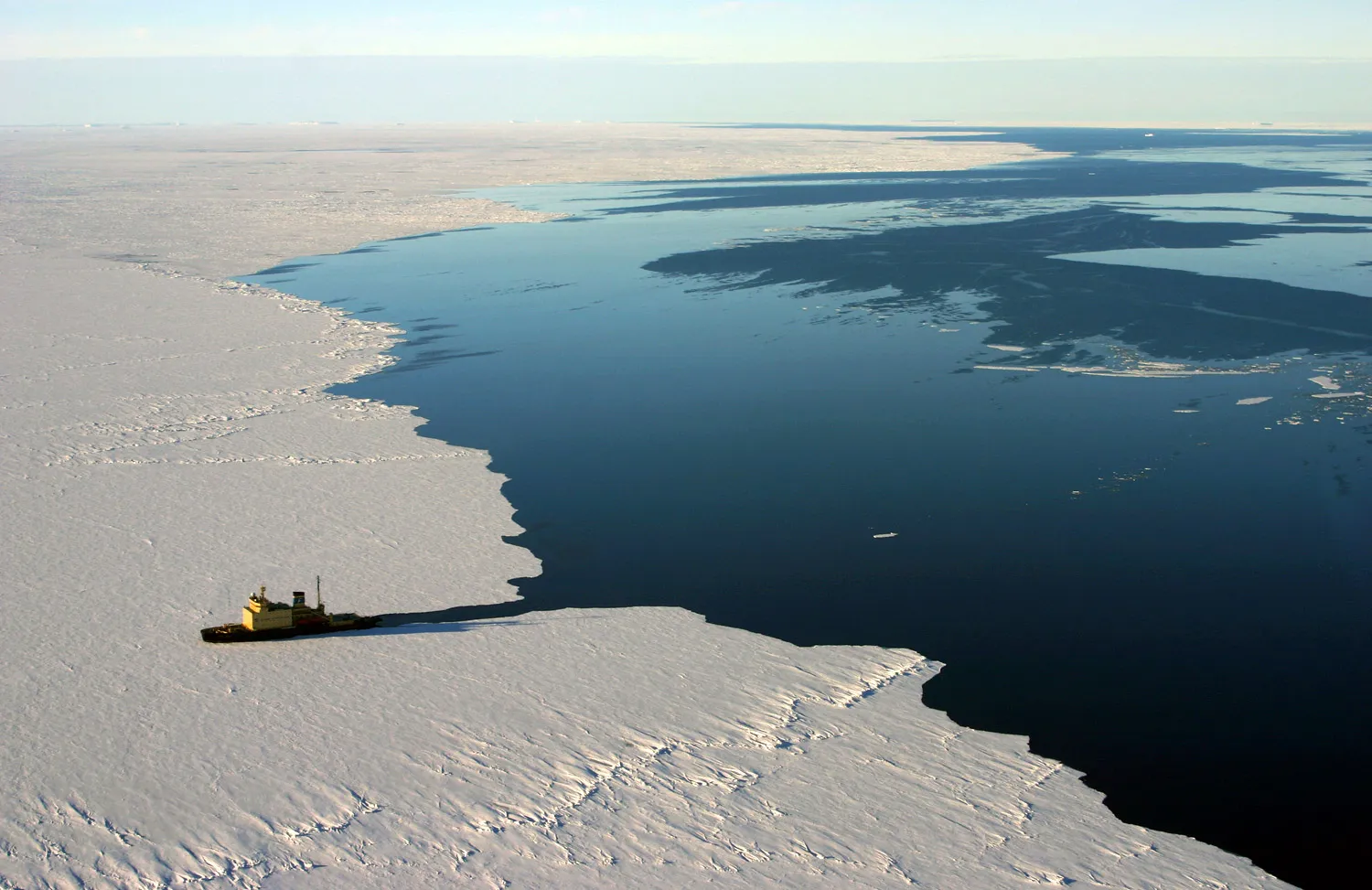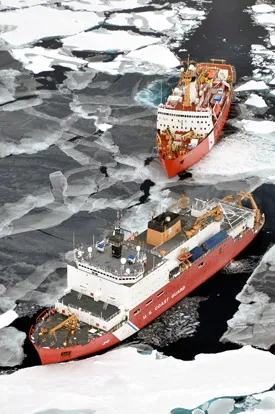Ice is dangerous to shipping. As well as the obvious danger of being holed and sunk, ships have been trapped by close ice and forced to drift for hundreds or thousands of miles over months or more than a year. Ships used in the polar regions ships today are usually strengthened to resist ice pressure, some have the right shape, design and enough power to actively drive through ice, the Icebreakers.
Icebreakers and Ice Strengthened Ships
 Ice-strengthened ships have been used since
the very earliest days of polar exploration. These were originally
wooden and based on existing designs, but beefed up,
particularly around the waterline with double planking
to the hull, strengthening cross members inside the ship and
bands of iron around the outside and / or metal sheeting at
the bows, stern and along the keel.
Ice-strengthened ships have been used since
the very earliest days of polar exploration. These were originally
wooden and based on existing designs, but beefed up,
particularly around the waterline with double planking
to the hull, strengthening cross members inside the ship and
bands of iron around the outside and / or metal sheeting at
the bows, stern and along the keel.Such strengthening was designed to help the ship push through ice and also in case the ship was "nipped" by the ice. Nipped is an innocuous sounding word to describe a terrible and powerful event when ice floes around a ship driven by winds and tides (often many miles distant) push against the ship trapping it as if in a vice and causing damage - sometimes damage enough to reduce the ship to match-wood.
Such damage might be survivable, it might cause the loss of the ship when the ice finally relents - the ship now no longer being able to float as happened to Shackleton's Endurance or it might cause the loss of the ship in as little as 15 minutes from first pressure being exerted. In the days of wooden ships, the only large vessel that could survive such treatment was the Fram, built for Fridtjof Nansen. The Fram was prodigiously strong, but it's chief defence was that when squeezed from the sides it would respond by rising up due to a rounded hull shape, though even the mighty Fram at one point looked to be be in danger when ice floes rose up to such an extent that they might fall on it and prevent it rising when squeezed. They didn't though and it survived.
 These days, ships that go to the polar regions are
of course no longer made of wood, but of steel. They still need
to be specially strengthened to work in ice conditions. An
ordinary ship with no strengthening will not risk touching ice
at all, no matter how gently. A modern ship weighing thousands
of tonnes meeting a small iceberg weighing perhaps as much again
or up to millions of tonnes and more can easily sustain enough
damage to require major repairs or to sink her. Ice will
easily hole a non-strengthened ship.
These days, ships that go to the polar regions are
of course no longer made of wood, but of steel. They still need
to be specially strengthened to work in ice conditions. An
ordinary ship with no strengthening will not risk touching ice
at all, no matter how gently. A modern ship weighing thousands
of tonnes meeting a small iceberg weighing perhaps as much again
or up to millions of tonnes and more can easily sustain enough
damage to require major repairs or to sink her. Ice will
easily hole a non-strengthened ship.Ships therefore that have any chance of contacting ice are at least ice-strengthened.
If they are designed to push their way through solid continuous ice as well, they are ice-breakers.
Icebreakers are needed if there is a shipping route to keep ice free, if there are military reasons for patrolling in areas with heavy sea ice or if you need to work in heavy ice conditions, particularly in winter. Icebreakers are expensive to build and very heavy on fuel to run (some are powered by gas turbines or a nuclear generator). All ships designed for the ice have rounded keels with no protuberances, there are no stabilizing fins as found on most ships and so they can be relatively uncomfortable to travel in on the open sea, ships that are designed to contact ice roll heavily in a even a light sea.
A rounded keel and lack of stabilizing fins means that progress is quicker and smoother through ice and that there aren't any parts to be ripped off. Further discomfort comes from breaking through continuous thick ice with constant vibration, noise and jarring against the ice.
Icebreakers are generally owned by those countries with an interest in the north-east and north-west passages in the Arctic or that have other shipping lanes and ports that need to be kept open during the winter months.
Ice strengthening on the other hand is found much more commonly in ships designed for Arctic or Antarctic work. There is no universal definition of what needs to be done to a ship to be "officially ice strengthened" and it can be applied to all manner of ships, supply ships, tankers, container ships, warships etc. Ice-strengthened ships can usually cope with continuous one year old ice about 50cm - 100cm thick.
A ship may break its way through ice by forcing it aside if the ice is thin or loose pack, if the ice is very thick the ship rides up and over the ice in front of it, which it breaks with its weight, this may happen with continuous progress or can result in a lot of back-and-forth in particularly difficult areas.
Characteristics of Ice
Breakers
Heavy for their size, to make them more effective at breaking through ice when they are pushed up above it by their engines.
Gradual upwards slope at the bow, particularly at the water line to allow the bow to ride up over ice before the weight breaks it.
Hull made from special steels designed for optimum strength at low temperatures.
Air bubbling systems to assist ice-breaking. Air is forced under pressure from 2m or so below the water line where ice is met, helping to break it and move it out of the way.
Heated water jets below the waterline to help when breaking through ice.
Ability to rapidly move large amounts of water ballast within the ship to shift the weight when needing to break ice. The ships can be rocked from side to side in this manner.
Hull divided by bulkheads into a series of watertight compartments in case it is holed.
Extra thick steel at the bow, also at the stern and at the waterline.
An "ice horn" to protect the rudder and propeller when in reverse, and an "ice knife" in front to protect it when in forwards motion.
Electric propulsion to the propellers. Electric motors can apply torque when not actually turning or when only turning slowly, so the propeller hitting a large piece of ice will not stop the engine.
Extra strong propellers with replaceable blades. There may also be a propeller inspection well to examine them in operation and the facility to change blades while at sea.
Very powerful engines. The engine may be diesel possibly with extra power supplied by gas turbines for ice breaking or even be nuclear powered.
Powerful searchlights for
use in dark winter conditions.
Characteristics of ice-strengthened
ships
Many of the ships that supply Antarctic bases are ice strengthened rather than full blown ice breakers.

Double hull, with a gap between them, the gap may be air or filled with water ballast. If the outer hull is punctured the inner will hopefully not be.
Flat hull shape with a rounded rather than pointed bow. This allows the front of the ship to drive forwards, rise above the ice and then let the weight of the ship break the ice.
Specially formulated hull polymer paints for strength and also low friction when in contact with ice.
Special engine cooling arrangements so that the inlet for water taken on board to cool the engine doesn't get blocked with ice - likewise the water outlet.
No stabilizers or any other kind of hull protuberance that might get ripped off by ice.
Helicopter, for scientific work, but also for spotting leads and open water in the ice to guide the ship.
Rudder and propeller protected by the shape of the hull, so that ice moving backwards is less likely to cause damage.
Thicker than normal steel, particularly at the bow and at the level of the water-line
Reinforced "ice belt" that typically extends about 1m above and below the water line, thicker hull steel and also extra internal ribs for stiffening. These are usually twice as many of these ribs than in a comparable normal ship.
Powerful bow and stern thrusters
to help maneuvering in tight spaces such as pack ice.
Picture credits: Top header strip - Cynthia Spence, NSF / Icebreaker entering sea-ice - Mike Usher / James Clark Ross, ice strengthened ship - British Antarctic Survey/ Pairof ice-breakers - NOAA, Collection of Dr. Pablo Clemente-Colon, Chief Scientist National Ice Center

